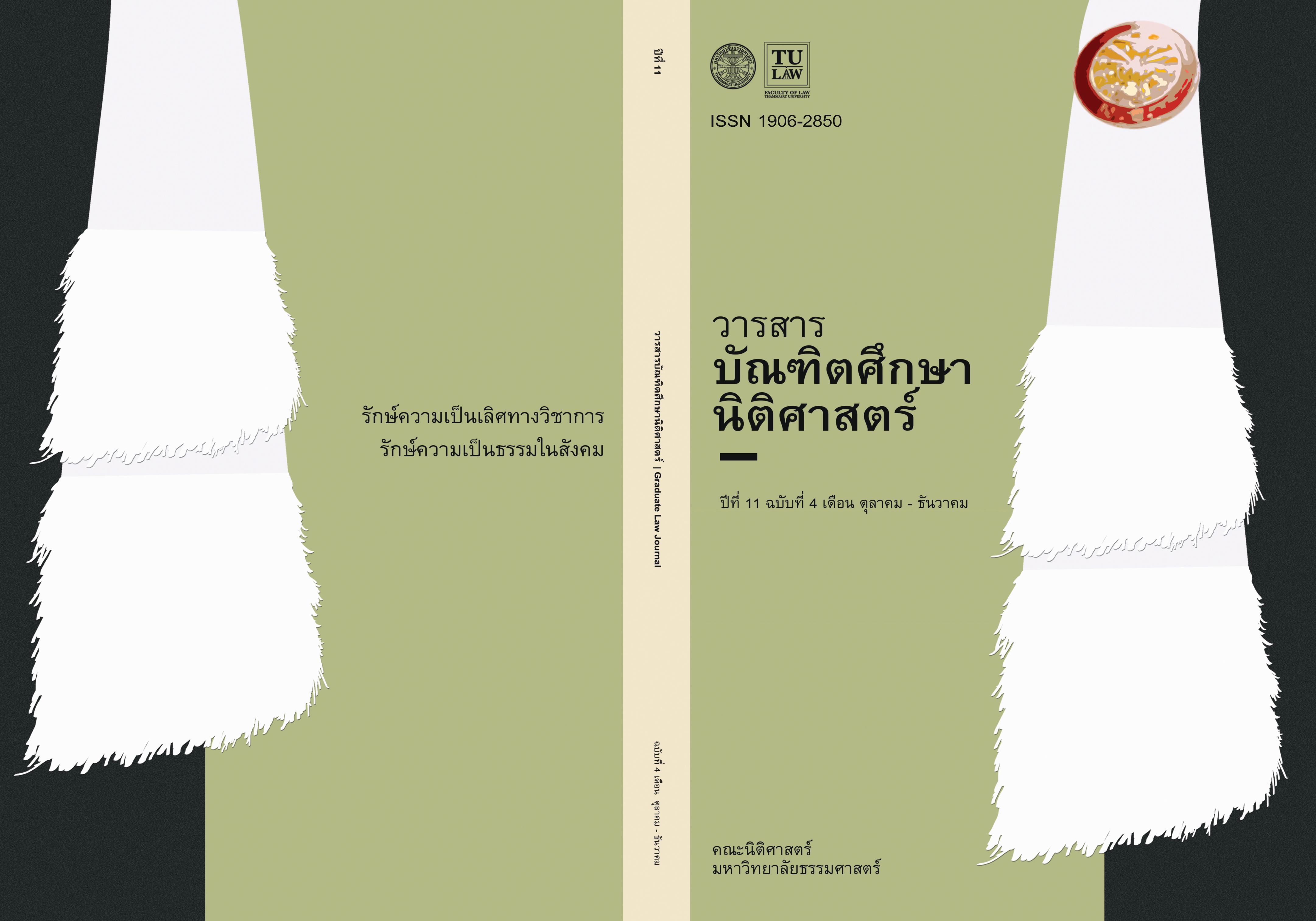Traceability measure for food safety in Thailand
Main Article Content
Abstract
This article is a documentary research that aims to study the problems and necessity in legislating the law on traceability of Thailand’s food products. By studying the criteria and regulations that are currently-enforced in Thailand involving safety throughout the whole food chain, the traceability in present-day food products according to how appropriate and thorough the food safety is can then be analyzed. Moreover, this study examines the sectors that are responsible in supervising and enforcing the regulations involving food safety in Thailand, and also makes suggestions based on the study of law and regulations regarding traceability in European Union, which is Thailand’s important trading partner that upholds traceability in legislating the law for food products both domestic and imported.
The study has shown that systematic traceability of food is indeed useful and beneficial for government sectors, entrepreneurs and customers as it allows to trace back to the point where food risk might occur in order to fix it accordingly, which not only guarantees the food safety but also controls meat distribution in case that epidemic in animals does occur. Moreover, data from traceability can be used for accurate product recall, to notify in rapid alert system and to facilitate the export of products to important trading partners such as European Union or the United States of America that have regulations on traceability of imported goods.
Currently, there is no systematic traceability of food products or traceability throughout the whole food chain in Thailand yet. However, many private sectors, that are mostly major entrepreneurs, willfully adopt it for the sake of convenience in traceability within organization, which adds value to products in high-end market, and for the purpose of international trading with countries that have such regulations. Therefore, the imported goods and domestic consumer goods in Thailand are yet to have systemic traceability or traceability throughout the whole food chain. Moreover, there are some inadequacies in data collecting for Thailand’s regulations on food safety. The example can be seen from the case of GAP standard in the primary production in paddy field, farm and ranch, which requires data collecting but is only a general standard that leaves to farmers’ willingness to follow. Other examples are the case of livestock products that have no regulation that require data collecting on animals entering and meat leaving the slaughterhouse, or the case of product transportation and distribution processes that have no regulation that require data collecting at all. These inadequacies leave the source of food production unbeknownst to the customers and the food products untraceable by the people involved, in case that food issue or crisis does take place. Even though there are plenty of sectors and institutes involving throughout the whole food chain but there is no central organization formally responsible with data collecting, examining and assessing risk throughout the whole food chain. This is why Thailand should have regulations regarding traceability that are distinctly specified for domestic consumer goods, imported goods and exported products. Such regulations can be legislated as general law for every type of food products, like in European Union, or only enforced on high-risk products such as meat or products that require special control such as infant food, which is the case in Japan. There should also be an organization specifically responsible for traceability, data collection and risk assessment throughout the whole food chain, so the case of food crisis can be handled effectively.
Article Details
บทความหรือข้อความคิดเห็นใด ๆ ที่ปรากฏในวารสารบัณฑิตศึกษานิติศาสตร์เป็นวรรณกรรมของผู้เขียนโดยเฉพาะคณะนิติศาสตร์ มหาวิทยาลัยธรรมศาสตร์ และบรรณาธิการไม่จำเป็นต้องเห็นด้วย
References
จิรารัตน์ รัตนคุปต์. “การศึกษาความสามารถในการแข่งขันและมาตรฐานความปลอดภัยด้านอาหารของสินค้ากุ้งส่งออกจากประเทศไทยและกลุ่มประเทศผู้ส่งออกหลักในอาเซียน กรณีศึกษา: ตลาดประเทศสหรัฐอเมริกาและญี่ปุ่น”. วิทยานิพนธ์ศิลปะศาสตร์มหาบัณฑิต มหาวิทยาลัยธรรมศาสตร์, 2556.
เบญจรัตน์ กนกวัฒนเลิศ. “มาตรการความปลอดภัยด้านอาหารของสหภาพยุโรปและการดำเนินการภายใต้กรอบกฎหมายของข้อตกลงว่าด้วยการใช้บังคับมาตรการสุขอนามัยและสุขอนามัยพืช”. วิทยานิพนธ์นิติศาสตรมหาบัณฑิต มหาวิทยาลัยธรรมศาสตร์, 2548.
ชุติมา พลายด้วง.”การพัฒนาระบบตรวจสอบย้อนกลับในห่วงโซ่อุปทานผักปลอดภัย”. วิทยานิพนธ์วิศวกรรมศาสตรมหาบัณฑิต มหาวิทยาลัยธรรมศาสตร์, 2556.
Ian Smith and Anthony Furness. Improving traceability in food processing and distribution : Deverloping traceability systems across the food supply chain, England : Woodhead publishing Limited, 2006.
Therese Vanasse. “HACCP and Traceability : An essential duo in agri-food industry.” http://www.vanasse-associes.com/wp-content/uploads/2014/10/HACCP-and-Traceability-essential-duo-AFF308_EN_ForWeb.pdf, 11 ธันวาคม 2560.
FAO. “CAC/GL 60-2006.” http://www.fao.org/fao-who-codexalimentarius/sh-proxy/ru/?lnk=1&url=https%253A%252F%252Fworkspace.fao.org%252Fsites%252Fcodex%252FStandards%252FCAC%2BGL%2B60-2006%252FCXG_060e.pdf, 11 ธันวาคม 2560.
European Commission. “General Food law.” https://ec.europa.eu/food/safety/general_food_law_en, 25 เมษายน 2561
Health & Consumer Protection Directorate-General, European Commission, “Food Traceability Factsheet,” https://ec.europa.eu/food/sites/food/files/safety/docs/gfl_req_factsheet_traceability_2007_en.pdf, 25 เมษายน 2561

